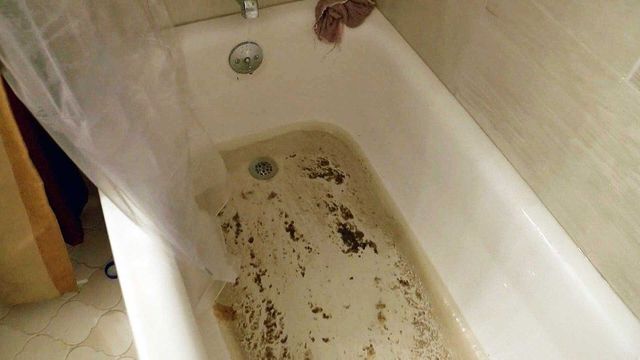Top Reasons for Drainage Coming Up in the Bathtub
Top Reasons for Drainage Coming Up in the Bathtub
Blog Article
They are making a number of good annotation on Why is There Sewage Coming Up Through the Bathtub in general in the content which follows.

Sewage backup in the bathtub can be a stressful and unhygienic problem for any kind of house owner. Not only is it inconvenient, however it also postures significant wellness threats and shows underlying problems with the plumbing system. Comprehending why sewage is turning up via the tub is essential for taking ideal activity to attend to the problem properly.
Introduction to the Concern
Usual Reasons for Sewer Back-up
Obstructions in the Sewage System Line
Among one of the most common sources of sewer backup is an obstruction in the drain line. This can take place as a result of the accumulation of debris, grease, or foreign items in the pipes, avoiding appropriate flow and triggering sewage to back up right into your bathtub.
Tree Root Invasion
Tree roots looking for wetness and nutrients can infiltrate sewer lines via little cracks or joints. Over time, these roots can expand and expand, creating considerable damage to the pipelines and leading to sewer backup problems.
Comprehending the Trouble
When sewage starts backing up right into the bathtub, it's a clear indicator of an issue with the water drainage system. The wastewater that should be moving away from your home is instead locating its way back right into your living space, which can result in considerable damages and carcinogen.
Potential Causes
Numerous variables can add to sewer backup in the tub. From obstructions in the sewage system line to concerns with the plumbing framework, determining the origin is vital for discovering an option.
Aging Infrastructure
Older homes might have obsoleted plumbing systems that are extra at risk to rust, splits, and damage. As pipelines age, they come to be extra prone to leaks and blockages, raising the probability of sewer back-up cases.
Heavy Rainfall or Flooding
During durations of heavy rainfall or flooding, the drain system might become overwhelmed with excess water, triggering backups and overflows. This can lead to sewer backing up right into bathtubs and various other components inside the home.
Indications of Sewer Backup
Foul Odors
Undesirable odors rising from drains pipes or components, particularly in the shower room, may suggest sewer backup problems. These smells are frequently solid and persistent, signaling a problem that requires immediate interest.
Slow Draining Fixtures
Bathtubs, sinks, and toilets that drain pipes slowly or otherwise whatsoever could be experiencing sewage backup. If several fixtures are affected concurrently, it's most likely that the problem originates from a common factor, such as the main drain line.
Gurgling Noises
Odd gurgling or bubbling sounds originating from drains pipes when water is running elsewhere in the house are indicative of air entraped in the plumbing system. This air buildup can result from sewage back-up and need to be explored quickly.
Health And Wellness Dangers Related To Sewage Backup
Contamination of Supply Of Water
Sewer back-up can infect the water supply in your home, presenting a significant wellness danger to you and your family members. Exposure to infected water can lead to gastrointestinal problems, skin infections, and various other illnesses.
Mold and mildew Development
Dampness from sewer backup can produce suitable conditions for mold development in your house. Mold spores can intensify breathing troubles and trigger allergies in sensitive people, making prompt cleaning essential.
Spread of Condition
Sewage contains unsafe germs, infections, and parasites that can trigger a series of diseases, including hepatitis, cholera, and gastroenteritis. Entering into contact with sewer or polluted surfaces puts you at risk of infection.
Tidying up After Sewage Back-up
Sanitation Procedures
Thoroughly sanitize and sterilize impacted areas after sewage backup to get rid of unsafe bacteria and protect against mold and mildew development. Usage suitable cleaning products and safety equipment to make certain risk-free and efficient cleanup.
Remediation of Influenced Areas
Repair any kind of damage to flooring, walls, or components caused by sewage backup. Depending on the degree of the damage, you might need to replace carpets, drywall, or other materials to restore your home to its pre-loss condition.
Immediate Actions to Take
Shutting Off Water Supply
In case of sewer backup, it's vital to switch off the water supply to prevent more contamination and damages. Find the primary water shutoff valve in your home and closed it off up until the concern can be dealt with.
Contacting a Professional Plumber
Dealing with sewer backup is not a do it yourself job. Get in touch with an accredited plumber with experience in handling sewage-related concerns to assess the situation and execute needed repairs or clean-ups.
Preventing Contact with Infected Water
Till the sewage backup is fixed, stay clear of contact with polluted water to avoid the spread of bacteria and virus. Put on protective equipment if you have to be in the affected area and clean your hands thoroughly later.
Safety nets
Regular Maintenance of Sewer Lines
Set up routine assessments and maintenance of your sewage system lines to identify and deal with potential issues prior to they intensify right into significant issues. This can consist of cleaning particles, inspecting for tree origin intrusion, and repairing any kind of broken pipes.
Setting Up Backwater Valves
Think about installing bayou shutoffs in your plumbing system to prevent sewer from receding into your home during durations of heavy rainfall or flooding. These shutoffs immediately close when water starts backing up, securing your residential or commercial property from contamination.
Appropriate Disposal of House Waste
Avoid purging anything apart from toilet paper and human waste down the bathroom to prevent clogs and clogs in the drain line. Dispose of oil, oil, and other house chemicals effectively to reduce the danger of plumbing issues.
What To Do If Sewage Starts Coming Up Through Your Bathtub
Sewage coming up through your bathtub is more than just gross. It poses a major health risk as sewage contains harmful bacteria and microorganisms that can be dangerous if exposed to them. While your tub or shower will certainly need a deep cleaning when this occurs, you’ll first need to get to the root of the issue.
If you notice sewage coming up through your bathtub, research Cherry Hill, NJ, licensed plumbers right away to get it fixed.
Why Sewage Is Coming Up Through Your Bathtub
The most common reason for sewage coming up through your bathtub is a clogged sewer line. All the sinks, toilets, and tubs connect to a single drain pipe that leads to the sewer line under your house. This drain line carries all wastewater and sewage away from your home to the city’s sewer system.
When the sewer line becomes clogged or blocked, wastewater has nowhere to go but back toward your house. This results in sewage coming up through your drains, often starting with your tub or shower.
The sewer line can become blocked by anything, but the most common culprits include:
Hair ? Cooking oils and grease ? Food waste ? Soap particles ? Children’s toys ? Jewelry ? Baby wipes or other non-flushable items ? Dirt ? Rocks ? Tree branches and debris ? Rodents How To Fix A Clogged Sewer Line
When you experience sewage coming up through your bathtub, it’s always best to contact a professional. Attempts to fix a clogged sewer line without experience often lead to more plumbing damage. However, you can try a few things that may loosen blockages in smaller connecting pipes.
Don’t Use A Plunger
Plungers only work to loosen obstructions near the head of the drain or toilet. It won’t be able to reach your sewer line or unclog the blockage.
Turn Off The Water
Turning the water off from the main valve will prevent excess water from flowing into already backed-up areas. This will also keep more sewage from coming up through your drains.
Check Your Vent Pipe
When vent pipes become clogged or blocked, it can lead to problems with the sewer line. By pulling any obstructions out of the pipe, your sewer line should be able to properly drain. The vent pipe can be located on your roof, usually directly over your bathroom.
Snake The Shower Drain And Toilet
Using a drain snake can help break up the object causing a blockage. By snaking both the shower drain and the toilet, you may be able to fix the issue. You’ll know you’re successful if the tub drains all sewage and wastewater.
Call A Professional
If these tactics don’t work, you will need to call a professional plumber. They will perform a camera sewer line inspection to find the source of the blockage and determine the best way to remove it. A professional will use a drain snake or conduct hydro jetting to unblock the sewer line and get things back in working condition.
If the obstacle blocking your drain line has caused any damage, you may also need your pipes repaired or even replaced.
Gurgling While Draining
Listen for gurgling sounds coming from the shower drain or sink, as this is an early warning sign of a clogged sewer line.
Frequent Clogs
If your toilet or other drains continuously become clogged, you need to call a professional to look at it. While you may be able to get the water or waste to drain again, it may only be a temporary fix.

Do you really like reading about Water Coming up Bathtub Drain? Post a short review down the page. We would be happy to know your views about this post. Hoping to see you back again later on. Are you aware of another individual who is truly interested in the niche? Feel free to share it. We appreciate reading our article about Water Coming up Bathtub Drain.
Book Appointment Now
Report this page